Wednesdays at the CSA: Going Local & Seasonal for Good
It used to be that I looked forward to the weekend. I still do, but it’s Wednesdays that I find most relaxing. That’s because Wednesdays are CSA Day, the day when I pick up my weekly share from the biodynamic farmer’s coop I’ve bought into.
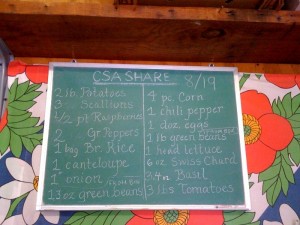
In addition to the wonderful food, it seems I always walk away with a pearl of wisdom. That’s probably because the CSA is located at an ashram, so there’s often a wise old yogi nearby speaking wise thoughts.
Today’s was: “You can’t please all of the people all of the time.” Boy, was that ever what I needed to hear today!
But back to the food…the tomatoes have just been killing me this season. They’re so fresh, so flavorful, so delicious, that the other stuff they call “tomatoes” that we buy year round at the grocers? Fuhgeddabout it!
That’s right…we’ve been so taken with the freshness and bounty of eating in season, that we’ve decided to try it year-round.
No more wasting money on expensive, out-of-season organic tomatoes in the dead of winter. I’d rather save my money for expensive, in-season, delicious local tomatoes during the summer!
This winter? I’ll stick with purple potatoes, nuts, and other foods we can eat seasonally. Of course, it’s a lot easier to make that type of commitment now in the heat of summer than in the cold of winter. I just have to remember that even in winter CSAs are More than Just Kale.
What about you? Have you made the switch to eating all local, all the time? Have you tried it? Leave a comment and share!
— Lynn
Copyright 2009 OrganicMania
<a name=”7778694112″></a>
Filed under Bethesda, Biodynamic food, CSAs, Food, Organics vs. Conventional Foods | Wordpress Comment (0) |How to Pack A Cheap and Easy Waste-Free Lunch
There are many eco-friendly options available for school lunch, but let’s face it: most of them are still pretty pricey. Shelling out $21 for a Sigg water bottle or $37.95 for a Laptop lunch box adds up to big bucks quickly.
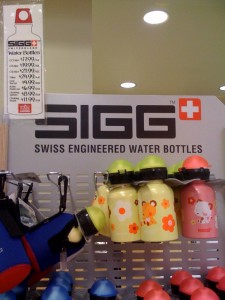
The very popular Sigg bottles range in price from $17.99 to $24.99 at this Bethesda Whole Foods.
Here are five super cheap, easy ways you can send your kids back-to-school with an eco-friendly lunch bag. If you’re fortunate enough to have what you need already, maybe you could take this post and send it to a school list serv or to others who might find this information helpful.
There are really just five things you need for a waste-free lunch:
1. Lunch box – or brown bag. While there are great eco-friendly lunch box options out there, most range from $14 on up. You can buy a pack of 100 brown paper lunch bags for $1.99. No, it’s not totally waste-free, but most municipalities recycle paper – so you can toss the bag out with the newspapers to be recycled! It’s a much more environmentally friendly option than buying a conventional school lunch bag, which are often made of PVC plastic. Read here to learn why you want to avoid PVC, which is harmful to our health and to the environment.
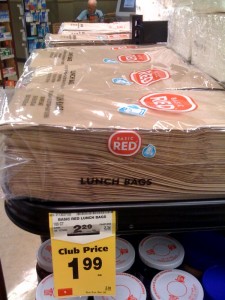
As seen in a Bethesda Safeway, buy 2 packages for $3.98 and you'll have enough recyclable brown bags for the entire school year.
2. Water bottles. This is a biggie. Visit nearly any school cafeteria and you’ll see a staggering amount of waste from disposable juice boxes and milk containers. Yet most stainless or non-PVC water bottles are $10 and up – some as high as $25 or more. Before I invested in two Sigg Mr. Sharky’s (pictured below), I used a good ole Honest Tea bottle. Made of durable glass, it was fine for drinks on the go. I still use one in a pinch!
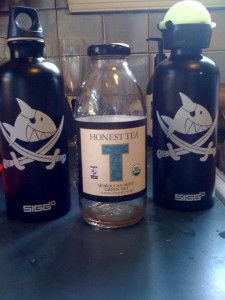
A durable glass bottle, such as this Honest Tea bottle, can be reused as an on-the-go water bottle.
3. Cloth napkin. No need to buy new here. Pretty much everyone has a spare dish rag or dish towel lying around the house, or some “good” cloth napkins that are only taken out for “special occasions.” These are perfect for school lunch. So far, my son hasn’t asked why he carries a linen dishcloth with a 1977 calendar on it, but I’m sure that day is coming soon…!

Yes, that's my mother's calendar dish towel from 1977, now doubling as a napkin in my son's lunch box. Do I get a Reduce, Reuse, Recycle, Refuse award for this?
4. Food containers. My how things have changed just in the past year. Now you can buy stainless steel containers for school lunch. But again, cost is an issue. If you don’t want to spend $40 for an all-in-one lunch kit or $16 for a stainless steel food container, you can go the el cheapo route like I did.
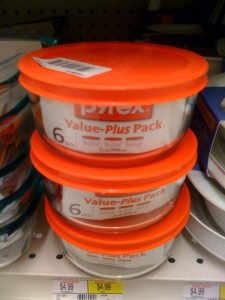
Three of these glass Pyrex food storage units sell for just $4.99 at a Bethesda Giant Food store.
Unfortunately there are no more of these nifty $4.99 glass pyrex containers at the Bethesda Giant, because I bought out their entire stock!
And here’s a shot of Big Boy with his lunch bag, which contains some plastic (gasp) Gerber food containers. I love these. They’re made in the good old USA, they’re cheap (under $5 for 4 small dishes) and they’re made of #5 plastic, which does not contain BPA. Still, to be on the safe side (because all plastics can leach) I keep these plastic bowls out of the dishwasher and the microwave I had to search high and low for these – they seem to sell out as soon as they’re in stock, but you can sometimes find them at Target or Buy Buy Baby.

He’s also carrying a more traditional “Green Mom” accoutrement – a Wrap n’ Mat sandwich wrap, which is made of washable cloth and durable, low density polyethylene (LDPE). These sell for $7.99 on the Internet, but I bought mine locally at My Organic Market. When I hit the Wrap n’ Mat website as I was writing this post, I learned that they’ve just introduced little snack pouches, which sell for $8.99 each.
5. Cutlery. This past school year I packed lunches with our regular cutlery, and unfortunately I regret it because some of our silverware never made it home. This year I’m trying Sporks !
And I leave you with a picture of my boys’ trusty Crocodile Creek lunch bags being cleaned out. Because this frugal green Mom isn’t planning to buy new ones this year!
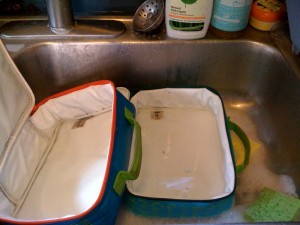
This post is for the Green Moms Carnival: Green Schools Edition, which runs tomorrow (Monday, August 10th) right here at OrganicMania.
— Copyright 2009 OrganicMania
Filed under Bethesda, Food, Giant, Green moms, Green Schools, My Organic Market, Product Recommendations, Savings Tips, School lunches, Sustainable Packaging, Tips, Whole Foods | Wordpress Comments (13) |Green Moms Carnival Is Up!

This month’s Green Moms Carnival is about Food. Food Matters. Of course it does. We all depend on a steady supply of healthy, nutritious foods. I wish all of our food could come from places like the beautiful, certified-humane organic Ayrshire Farm, pictured above. I snapped this photo on Monday while touring the picturesque 1,000 acre farm in Upperville, Virginia.
Check out the posts over at A Passion for Green Business. I guarantee you’ll learn a lot about why Food Matters.
— Lynn
Filed under Food, Green moms, Organic Prices | Wordpress Comment (0) |Food Matters: The Response to that Post Article about the National Organic Program
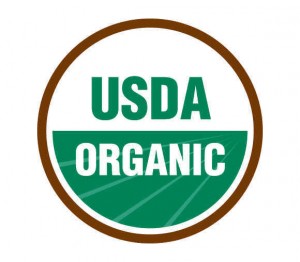
Nearly two years ago I started OrganicMania because I was going crazy trying to figure out when it made sense to go green and organic.
Once I finally understood the food labeling systems (USDA Organic, Made with Organic Ingredients, Green, Natural, etc), I felt a bit more sane.
But as I blogged here last week, the news that Organic Standards may not be all that they seem has turned my world upside down again. Two years later, and I’m still being driven crazy trying to sort out green and organic claims!
The Washington Post ‘s coverage of the controversy surrounding the National Organic Program touched off interesting reactions from organics advocates and observers. I was barely digesting that story and the reaction to it when Whole Foods announced they’ve joined the non-GMO project, and Dean Foods announced a move toward “natural” milk – two developments that will throw yet another wrinkle into the food shopping game. I don’t typically do news summaries here at OrganicMania, but I think these developments are so significant that they merit a recap.
So this is News? Samuel Fromartz, author of “Organic, Inc,” blogged that “The tension discussed in the [Post] article, between those who have always sought to expand the industry and those who seek a more purist vision…. wasn’t particularly news…As for synthetics in processed food, there will always be two camps on this — and both present risks. If synthetics are taken out ..organic processed foods would fade off the shelves. Maybe that’s not a bad thing, but the organic industry would be a lot smaller. If, on the other hand, too many synthetics are let in, and we start getting more organic junk food with a long list of unpronounceable ingredients, that will spell the end of organics too.”
It’s So Unfair! The Organic Trade Association issued this press release taking issue with the criticisms aired by The Washington Post reporters. I wish I had seen more reaction from organics advocates, but this was the best response I could find after much online searching, so I’ve included the key points below.
o “The federal organic standards have not been ’relaxed.’ Rigorously enforced standards can and do go hand-in-hand with growth… Organic agriculture and products remain the most strictly regulated, as well as the fastest growing, food system in the United States today.”
o “Organic agriculture protects the health of people and the environment by reducing the overall exposure to toxic chemicals from synthetic pesticides that can end up in the ground, air, water and food supply, and that are associated with health consequences from asthma to cancer. Extensive pesticide residue testing by the U.S.D.A. has found that conventionally produced fruits and vegetables are, on average, three to more than four times more likely to contain residues than organic produce, eight to eleven times more likely to contain multiple pesticide residues, and contain residues at levels three to ten times higher than corresponding residues in organic samples.”
o “..There is a very specific process that materials must go through before they are permitted for inclusion in organic products. In regards to fatty acids, the USDA regulators followed the recommendation of the National Organic Standards Board (NOSB)… Because the position of the reporters’ sources did not ‘carry the day’ in this public review by no means makes the process illegal, and to characterize it as such is a great disservice to the public.”
Also last week, Whole Foods announced it will begin certifying certain of its private label 365 brand foods through the Non-GMO Project. I believe this will be the first major non-GMO labeling effort of its kind – something we should all support. But I predict that Whole Foods’ move will drive more consumers away from organics and toward the new non-GMO label, since many people buy organics primarily to avoid GMOs.
Perhaps USDA Organic is not the “be all and end all” that its most ardent supporters claim. But it’s one of the best indicators we have of quality food, particularly in the supermarket. As consumers, we need to continue to push for strong organics standards, meaning no relaxation of the current USDA Organic standard. Check out this campaign promoted by Terressentials Organics to solicit consumer support for upholding organic standards. You have until August 31st to have your voice heard by the National Organics Program.
My bet is that the continued expansion of organics, the growth in the natural foods and green categories and the new non-GMO label will continue to make food shopping a challenge – meaning I’ll still be going crazy! (At least it will give me plenty to blog about here at OrganicMania!)
Check out the other wonderful posts in this month’s Green Moms Carnival, hosted by Alline at A Passion for Green Business.
What do you think? Are you still going crazy trying to sort this all out? Leave a comment and share!
— Lynn
Copyright OrganicMania 2009
Filed under Food, GMOS, Organics, Organics vs. Conventional Foods | Wordpress Comments (9) |5 Things You Can Do About Those National Organic Program Rumors Repeated in The Washington Post
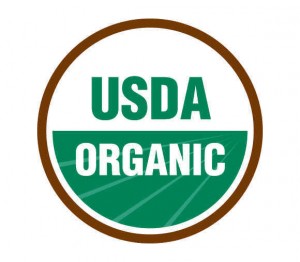
For some time now, I’ve come across rumors of troubles with the National Organic Program (the body responsible for bestowing the coveted USDA Organic Seal and Certification). Whether it was comments from disgruntled farmers on message boards and blogs, grumblings from members at my biodynamic CSA, the time a Chilean woman came up to me at Whole Foods and laughed in my face for buying organic grapes before delivering a lecture on how “organic” food is really grown, or a half-dozen or so similar encounters…well…I’ve wondered. But what was I going to do? Blog about rumors? Some blogs run that way, but I like to have facts on my side. (I’m still a former newspaper reporter, after all!)
Now those rumors have gained more credence with a Washington Post article which makes the following allegations:
1. USDA Organic does not mean pesticide-free.
- According to The Post, “The original law’s mandate for annual pesticide testing was also never implemented — the agency left that optional… In 2004, Robinson [ the administrator of the USDA Organics Program] issued a directive allowing farmers and certifiers to use pesticides on organic crops if “after a reasonable effort” they could not determine whether the pesticide contained chemicals prohibited by the organics law.”
2. The list of non-organic substances allowed in USDA certified organic foods has increased from 77 to 245 substances since the standard was created in 2002. As The Post says, “The goal was to shrink the list over time, but only one item has been removed so far.”
3. The Post alleges that there are quality differences in organic certifying bodies, with some practicing more stringent certifications protocols than others. One it singles out for particular criticism is Quality Assurance International (QAI). The organic certifying body’s seal is on organic packaged items, although typically the seals and the country of origin are printed in very small type, so I’ve found that you have to look carefully to find these seals.
4. USDA Organic may NOT even mean 100% GMO-free. This is particularly troublesome given that avoiding GMOs is one key reason people, particularly parents, pay extra for the organic seal.
So what’s a frustrated shopper to do? I’ve taken the following steps. And based on the Post article, I’ll redouble my efforts to do so:
1. Find a local CSA or farmer’s market that you trust. Local is always better, because fresh-picked food retains more nutrients and because the carbon footprint involved in food transport is smaller. (Disclosure: I recently welcomed one of the nation’s leading farmer’s markets, FRESH FARM Markets, as a consulting client).
2. Avoid imported organic foods from countries with questionable food safety, heavy pollution, and lax regulations. For me, this means China. Soybeans are particularly suspect. It can be a challenge to find USDA organic soybeans that are not imported from China.
3. Purchase frozen foods from countries with strong health and safety records. When I’m not buying fresh veggies, I always look for frozen organic veggies produced in the US. Sometimes I buy frozen foods from France, as I blogged here. They may not be organic, but I know they don’t contain GMOs because they’re forbidden by law in the EU.
4. Think about whether you really want to pay a premium for the USDA organic seal on processed foods. If you’re buying some chips for the kids as a treat, maybe the “natural” label or plain old conventional food will do.
5. Demand accountability from Washington. The USDA Organic Seal should stand for pure, organic food free of GMOs, chemical pesticides, and synthetic additives.
I’m curious to hear your thoughts. Please leave a comment and share! I love my tweeters, but please leave a note too!
— Lynn
Copyright OrganicMania 2009
In MoCo? Hit the WholeFoods Kentlands Tuesday/Wednesday for Huge Savings
I have no idea what’s going on at the Whole Foods Kentlands. I normally don’t shop there – not worth the hike from Bethesda. I guess a lot of people feel that way, because they’re cutting prices to drum up business.
Check out these amazing deals:
– Today (Tuesday) you can get buy one, get one free deals. Unfortunately, there’s no way to know what’s on sale until you get to the store…so if you live a distance, better wait till
– Wednesday, June 17th and June 24th, when you spend $100 or more you get 20% OFF
– They also have a sale on Thursday – spend $50 and get a FREE 24-pack of 365 Everyday Value 16.9 oz water bottles. (I dislike plastic water bottles, but with summer birthdays coming, they’re not a bad option!)
If you make it to the Kentlands Whole Foods, let me know!
Happy Shopping!
Lynn
Filed under Coupons, Food, Organic Prices, Savings Tips, Whole Foods | Wordpress Comment (0) |The BPA Battle Heats Up: The Endocrine Society Takes a Stand
The other week I noticed that a somewhat-obscure scientific organization, The Endocrine Society, was meeting in Washington, DC. For a moment, I stopped and wondered if they too might weigh in on the bisphenol A (BPA) debate now raging in DC.
“Nah,” I thought. “They’re non-political. I’ve never heard about them. They’ll just report on research, but they won’t actually make a statement or engage in the debate.”
Wow. Was I wrong.
As I learned from – once again – the Environmental Working Group – The Endocrine Society actually issued its first ever scientific statement on BPA – the first in its 93-year-history. The Society warned that BPA and other endocrine-disrupting chemicals (EDC) “ have effects on male and female reproduction, breast development and cancer, prostate cancer, neuroendocrinology, thyroid, metabolism and obesity, and cardiovascular endocrinology.”
The Society also warned that “The Precautionary Principle is key to enhancing endocrine and reproductive health, and should be used to inform decisions about exposure to, and risk from, potential endocrine disruptors.”
[For more on the Precautionary Principle, see this OrganicMania interview with Diane MacEachern, author of The Big Green Purse and a Founding Member of The Green Moms Carnival].
You can access the entire Scientific Statement here. It’s dense reading, and I confess I haven’t made it all the way through as yet – but what I have read is troubling. The report documents possible links between endocrine-disrupting chemicals like BPA and a host of serious health issues such as cancer, ADHD, autism, and low sperm count.
In a separate action, EWG President Ken Cook sent a letter to Coca Cola’s CEO in which he noted “More than a decade ago, because of concerns about high levels of BPA in bioassays of teenagers and young adults, most Japanese food processing removed or dramatically reduced the use of BPA in can linings, switching to safer, less expensive PET(polyrthylene terephthalate) film lamination. As a result, a 2002 study found that BPA levels among Japanese students dropped by fully 50 percent between 1992 and 1999.”
Can you believe it? Those numbers are stunning.
When I started OrganicMania, I thought the main health issue we Moms faced was the food we put in our bodies. Little did I know it was just the tip of the iceberg. Plastic bottles, cans, household cleaners, make-up, baby shampoos, lotions and potions – I’ve learned that substances like these contain minute amounts of carcinogens, endocrine disruptors and other chemicals. Scientists and regulators are still sorting out the cumulative effects of all these exposures. As for me, there’s enough evidence there to follow the Precautionary Principle. That means sticking to simple, basic foods, make-up and personal care products, buying organic and natural whenever possible, and avoiding synthetic compounds.
I’ll be blogging a lot more about these issues in the future. I feel like the scales have fallen off my eyes. It’s not just about the food. It’s about so much more than that. What do you think? Leave a comment and share.
Lynn
Copyright OrganicMania 2009
Filed under Cancer, Food, Green Charities, Green Cleaning Products | Wordpress Comments (3) |Organic & Green Savings: CVS, Whole Foods & Bethesda’s Giant Food
It’s been a while since the last Green and Organic Savings feature. With all this child advocacy, green activism, and taking care of clients, I’ve not had time for long, leisurely shopping trips. Mr. OrganicMania has picked up the slack, but that’s going to change.
Anyway, this week, you didn’t even need to make it to the stores to see some fabulous deals at Whole Foods, Safeway and CVS, thanks in part to some old-fashioned direct mail pieces and newspaper inserts.
CVS has an incredible deal running on Physician’s Formula make-up. With your CVS card, you can buy one, get 50% off one Physicians Formula cosmetic. And check your newspaper coupon insert today. The Sunday Washington Post has a $1 off coupon for Physicians Formula. As I blogged here, not all of their products score the best ratings in the Cosmetics Safety database, but five of their 185 products score “low hazard” ratings, so OrganicMania recommends you try these Physicians Formula products: liquid eyeliner, finishing veil, pressed powder, concealer stick, and extra sensitive skin sunblock. If you have questions, you can check out their ratings at the Environmental Working Group’s Cosmetics Database here.
Next time you’re in Whole Foods, be sure to use the Green & Black’s $1 off coupon from the Whole Foods Whole Deal newsletter (good through July). I’ve raved before about Green & Black’s delicious organic chocolate here at OrganicMania, over at Big Green Purse, and at The Daily Green, but since it’s nearly summer I decided to try their ice cream. Wow. It’s fantastic! Thanks again to my bloggy friend Wrekehavoc for turning me on to Green & Blacks Organic!
If you’re anywhere near Bethesda, be sure to check out the Arlington Road Giant, which is running a triple coupon deal through June 4th. You can find the triple savings coupons in a newsprint mailer sent to area homes. Now of course you don’t want to use those coupons for junk food, so I decided to scour the net to look for organic coupons for under $1 each that could be used at Giant to qualify for triple savings. The Giant deal means you can save up to $2.97 on each of five items, for $14.85 in savings! After looking at national organic brands with distribution at Giant including Stonyfield, Ian’s, Newman’s Own, Green & Black’s, Amy’s Organic, Annie’s Naturals and Earthbound Farm, incredibly I could only find valid online coupons (those under $1) at Stonyfield Farm. (Disclosure: Stonyfield is a sponsor of OrganicMania’s trip to BlogHER, but honestly I couldn’t find valid under $1 coupons anywhere else! Leave a comment some if you happen to find them!)
Stonyfield has 14 different online coupons available including .50 off their new Oikos organic Greek yogurt, as well as organic milk, Yo Baby, Smoothies and more. You need to register here before accessing the e-coupons.
Did you find any other great deals on organic and green products? Leave a comment and share!
Note: I’m looking for two additional sponsors to help defray the cost of my BlogHER trip. If you represent a sustainable brand that you think may be a good fit with OrganicMania, please email me at organicmania at gmail dot com.
Lynn
Copyright 2009 OrganicMania
Filed under Bethesda, Coupons, CVS, Food, Giant, Organic Prices, Product Recommendations, Savings Tips, Where to Buy Organics, Whole Foods | Wordpress Comments (4) |Getting Started with Seedlings: Make Your Own Recycled Starter Pack Containers
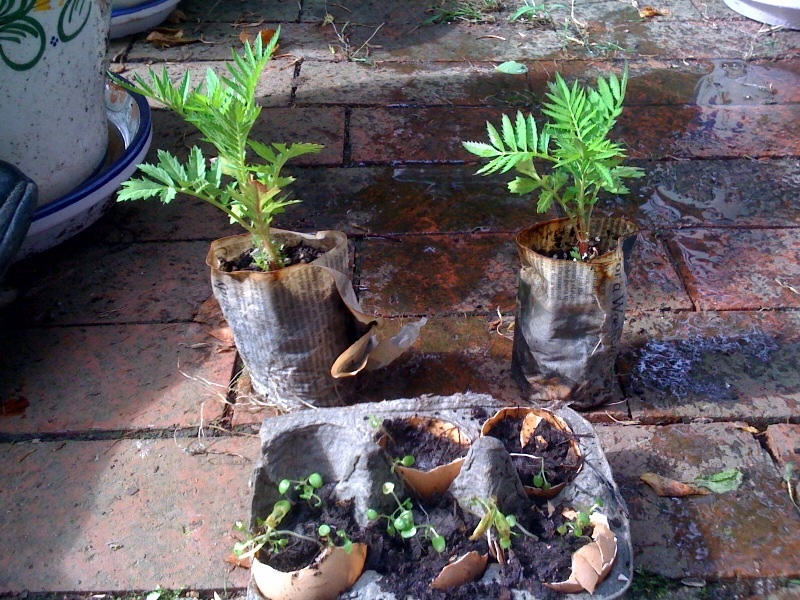
Success with eco-friendly seed pots!
Perhaps, like me, you’ve made the decision to try your hand at raising plants from seed this spring – only to discover that your eco-friendly plans go awry when you realize you have no containers on hand! A quick trip to my storage area didn’t turn up much, so I reached out to my bloggy friend Jess of The Green Phone Booth (and formerly of Surely You Nest), hoping we might be able to stage one of our rare reunions so that I could pick up some cast-off seed starter pots.
A died-in-the-wool Earth Mother who was raised by a Green Mom before they called themselves Green Moms, Jess went one better on me. She had no cast-offs to share, but she did share some of her gardening wisdom. She suggested toilet paper, egg shells, or newspapers. And knowing full well that those suggestions would leave me flummoxed, she helpfully pointed me to this great post from Planet Green, which suggests whipping up planting pots from egg cartons, yogurt containers, newspaper and toilet paper rolls.
The egg cartons seemed easiest to me – I’ve got plenty on hand and frankly, as I’m not really the artsy-crafty type, I found the instructions for the toilet paper and newspaper options a bit too complex.
Turns out fellow Green Mom Jenn Savedge, aka The Green Parent, is also a fan of egg cartons for seedlings, as she explains here. Here’s what works for me, based on tips from all three of these fabulous green women – JessTrev, Jenn Savedge and Jasmin Malik Chui.
1. Figure out how many seedlings you’re going to start, and make sure you have enough egg cartons and egg shells on hand.
2. Yes, as Jenn points out, you’ll want to wash those eggshells first with a gentle cleanser and water. I’m using the produce rinse for this job too!
3. Take a pin and poke a tiny hole in the bottom of each egg shell.
4. Fill with soil (hopefully organic compost from your compost bin), and drop several seeds inside.
5. Voila – once the seeds have sprouted, you can take the eggshells and the cardboard egg carton holders and plant them directly in the ground!
Not only is this a great project for home, but think about all those other times when you’re asked to come up with a craft project for the kids. This is a great spring craft project for school, scouting, or Sunday School. Works for me!
— Lynn
Note: As you can see, I updated this post with a pic of my successful seedlings sitting besides some newspaper pots I purchased at my CSA!
Copyright OrganicMania 2009
Filed under Easy Green Weekend Projects, Food, Green Ideas & Stuff | Wordpress Comments (9) |Organic and Green Savings: Is Bigger Always Better? No!
I felt the sisterhood of Moms everywhere as I dashed into Whole Foods, desparately looking for a reasonably priced, healthy snack for more than 30 kiddos. Yes, I was “Snack Mom,” and I had all of 10 minutes to figure out what to serve the after-school crowd waiting for me down the street.
That’s when I spied this display of Apple & Eve organic juice boxes, 27 for $13.99. Of course, I hate juice boxes – they rarely get recycled at kids’ events. But when I looked for paper cups to go with the large glass jugs of juice, I couldn’t find any. So boxes it was. How else are you going to feed a group that large?
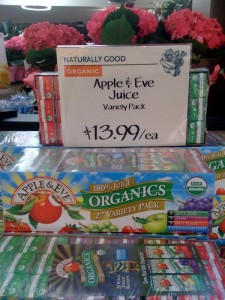
Before heading to the register, I looked at the smaller packs of Apple & Eve juice – 8 for $3.69. I whipped out my calculator, just to make sure I was getting the best deal with the 27-pack, and much to my surprise discovered that it was actually less expensive to buy the smaller 8-packs, at 46 cents for each box versus 52 cents each in the large 27-pack.
How annoying. How can that be? Finding the best deal for a large group shouldn’t involve arithmetic problems in the shopping aisle.
But it does. So if you’re shopping, make sure to bring along a calculator – or use the one in your mobile phone – to make sure you’re getting the best deal. Big displays and large signs touting prices don’t always mean you’re getting the best price.
Of course, most green consumers will also consider packaging, which definitely points you to the larger, more efficient package (which is what I ended up buying – it helped that with 35 kids to feed, the numbers worked in my favor). But I’d like to know why producers would price products this way in the first place, especially companies like Whole Foods and Apple & Eve, that are making a play for the “green” consumer.
Other deals that are easier to spot?
Grapefruits – 10 for $10 are a great buy, on sale now at Whole Foods and other grocers. They’re satisfying, refreshing, and packed full of nutrients like Vitamin C and the antioxidant lycopene. And no, you don’t need to buy them organic for health reasons. Any pesticides used don’t penetrate the thick skin. But do be sure to wash the skin and knives carefully before eating. Try feeding them to your little tykes. Two-year-old Boo loves them, but my six-year-old Big Boy won’t touch them.
Organic Apples – Organic apples are now cheaper than conventional in many stores. Check them out at Giant, Whole Foods, and Trader Joes, and you may find great deals.
Happy Shopping!
— Lynn
Copyright 2009 OrganicMania
Filed under Food, Organic Prices, Organics vs. Conventional Foods, Savings Tips, Sustainable Packaging, Whole Foods | Wordpress Comments (2) | My StumbleUpon Page
My StumbleUpon Page



